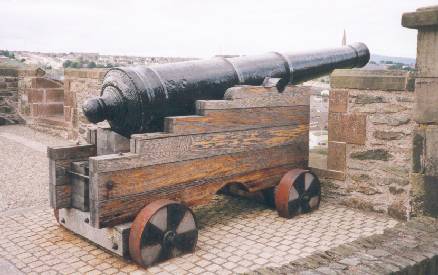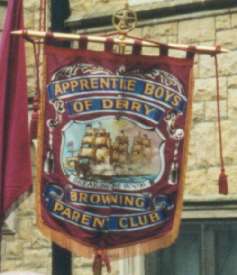




The Siege of Derry in Ulster Protestant mythology
Ian McBride's book, "The Siege of Derry in Ulster Protestant Mythology", looks at the ways that the siege has been commemorated through the years since 1688-9, and how the event has been seen differently by successive generations. Before reviewing the book, it may be useful to give a brief introduction to the siege itself.
What was the background of the siege?
The Williamite war in Ireland (1688-1691) can be viewed as part of a serious European conflict, prompted by the increasing power of the French King, Louis XIV, le Roi Soleil. In 1685, Louis had revoked the Treaty of Nantes which had granted religious tolerance to French Huguenots. He had also reformed the French army and had started to expand the borders of France, taking over regions such as Alsace and the principality of Orange. William Henry Nassau, Prince of Orange and stadtholder of Holland, became a leading figure in the League of Augsburg which was formed to oppose Louis XIV.
In 1685, the Roman Catholic James II came to the throne of England. His agent Richard Talbot, earl of Tyrconnell, started to dismiss Protestant officers from the army in Ireland, replacing them with Roman Catholics. For English Protestants, the last straw came when the birth of a son to his second wife meant that his Protestant daughter Mary would not succeed to the throne. In the summer of 1688, a group of seven English notables sent a message inviting Mary's husband, William of Orange, to take the English throne. William sailed to England with a formidable army of 15,000 men, and landed at Torbay in November 1688. James fled to France, but then came to Ireland in March 1689, with the hope that he could regain the throne with the help of supporters in France, Ireland and Scotland.
Apprentice boys
In December 1688, the people of the city of Londonderry had been faced with a dilemma. Tyrconnell had ordered a Catholic regiment (Lord Antrim's Redshanks) to take over the garrison, replacing Mountjoy's regiment which had been sent to Dublin. Protestant fears of a repetition of the 1641 massacres appeared to be confirmed by a hoax letter, discovered in a street in Comber, Co. Down. This anonymous letter warned that Irishmen were going to "murder man, wife and child" on the 9th December 1688. However, as Bishop Hopkins pointed out, James was still the lawful king and to resist his soldiers was rebellious act.
| On 7th December 1688, when the first companies of Redshanks had crossed the Foyle by ferry, and a group of young apprentices took matters into their own hands by closing the gates of the city. A compromise was eventually reached, allowing two Protestant companies of Mountjoy's regiment to return to Londonderry, to supplement six companies raised by the citizens themselves. Lieutenant-Colonel Robert Lundy, a Scottish episcopalian, was appointed as military governor, and he started to improve the defences of the city to meet a likely Jacobite attack. |
|
No surrender!
 Defenders' artillery on the walls - 64k |
By April 1689, only Londonderry and Enniskillen had yet to fall to the Jacobites, and prospects looked bleak when Lundy's troops had to retreat from a battle near Lifford. When he arrived back at the city, Lundy refused to allow reinforcements from a relief fleet to join the garrison. On 18 April, James II arrived at the city, apparently unaware that terms for surrender had already been discussed. Suspecting betrayal, the defenders opened fire, killing one of the King's party. The citizens had by now decided that Lundy was either incompetent or sympathetic to the Jacobites, so they appointed Rev George Walker and Major Baker as joint governors. Lundy was allowed to escape from the city, disguised as a common soldier and carrying a bundle of match.
The 105 day siege had begun, but the besieging army had a shortage of artillery which would be needed for a full-scale assault on the city walls. However, guns and mortars placed in Captain Stronge's orchard on the other side of the Foyle were able to fire on the city with deadly effect. The mortars were particularly terrifying, since their high trajectories sent bombs crashing through the roofs of houses. The defenders were equipped with about twenty artillery pieces which had been supplied by the London companies, including one called "Roaring Meg" which was a gift from the Fishmongers of London. Conditions within the overcrowded city became desperate as shortage of food and disease began to take their toll. Conditions for the Jacobites were scarcely much better, with inadequate shelter in very wet conditions.
The basic Jacobite strategy was to blockade the city until the defenders were forced to surrender. However, there were a number of encounters between the opposing forces during the siege. The first occurred on 31 April when Alan Murray led his cavalry to attack the Jacobites near Pennyburn. He was forced to retreat, but as he did so he led the Jacobite cavalry into an ambush prepared by the infantry. On 6 May, Murray successfully led a attack on Windmill hill, which had been captured by the Jacobites on the previous day. About a month later a more serious battle was fought at Windmill Hill, with the defenders being driven back to the walls of the city.
On 28 June, the most dangerous attack of the siege was made when two pieces of artillery were brought to fire at the Butcher's Gate, and a mine was dug to a cellar underneath one of the bastions. The attack was only repulsed after a fierce struggle by the defenders. At the start of July, Marshall de Rosen brought Protestants from the surrounding countryside to the walls to try to put more pressure on the dwindling supplies of food in Londonderry. The defenders responded by threatening to hang prisoners on the Double Bastion unless the non-combatants were allowed to return home. Hamilton objected to de Rosen's strategy, and the orders were countermanded.
Breaking the boom
 Breaking the boom - 33k (Apprentice Boys' bannerette) |
At the start of June, a wooden boom had been constructed across the Foyle to prevent ships arriving to relieve the city. On 8 June, the warship Greyhound made an attempt to approach the city, but ran aground and came under fire from Culmore fort. As this ship returned damaged to England, the rest of the fleet, with troops commanded by Major-General Kirke, did not attempt to break the boom. Instead some ships sailed to Lough Swilly to land on Inch Island. The boom was protected by some of the Jacobite artillery, and presented a formidable obstacle in the difficult conditions of the Foyle.
Eventually, on 28 July, three merchant ships called the Mountjoy, Phoenix and Jerusalem sailed towards the boom, protected by the frigate Dartmouth. The Mountjoy hit the boom, but rebounded and ran aground. Sailors in a longboat from the Swallow also reached the boom and attacked it with hatchets. The Mountjoy fired its guns at approaching Jacobite troops, and the recoil helped to refloat the ship. The boom was broken, and the Phoenix and Mountjoy were able tie up at the Shipquay to unload their precious cargo of food for the starving people of the city. By the evening of the 31 July, the Jacobites could be seen burning their encampments and marching off towards Lifford.
Ian McBride's book
Ian McBride's book gives only a brief summary of the siege itself, and instead focuses on the way the siege has been interpreted and commemorated over the years since 1689. Divisions between Protestant conformist and non-conformist views surface in the early years, but sermons in the eighteenth century tended to portray the siege as a providential deliverance from popery. The story continued to be told through the years of Volunteer companies and political reform in the late eighteenth century. The siege was also a potent source of imagery during the arguments about Home Rule in the late nineteenth and early twentieth centuries.
Ian McBride points out that the officers and men in the siege were never properly paid for their defence of the city. William Hamill, acting of behalf of the garrison, battled for thirty years to have the debt paid, but without success. Peter Robinson (with the help of the House of Common's researchers) has estimated that the garrison is owed about £25 million pounds, before taking interest into account!
In the early eighteenth century, non-conformists were very unhappy about being treated as second class citizens after helping to defend the city - the test act in 1704 meant that 10 aldermen, including 6 former mayors, were forced to resign. The Rev. George Walker, who became the civil governor of the city and later was killed at the Battle of the Boyne, was not popular with non-conformists since he did not give them much credit for their part in the defence. For example, he listed the names of the 18 Anglican clergymen in the garrison, but claimed that he was unable to learn the names of any of the 7 nonconformist ministers.
|
This type of attitude to non-conformists led Rev. James McGregor of Aghadowey (who, it is claimed, was at the Siege as a boy) to lead some of his congregation across the Atlantic "to avoid oppression and cruel bondage" and to establish the town of Londonderry in New Hampshire. At the centenary celebrations in 1788-9, the people of Derry wore Orange ribbons (just as people in England did at the time when celebrating the Glorious Revolution) and a red or crimson flag was flown at the Cathedral. The Roman Catholic clergy joined in the celebrations and "vied with Protestants in expressing, by every possible mark, their sense of the blessings secured to them by our happy Constitution". My conclusion is that the book is rather expensive, but it does give some very interesting insights into Ulster Protestant traditions over the years. |
|
Book reviewed:
Ian McBride,
"The Siege of Derry in Ulster Protestant mythology".
See also:
Londonderry / Derry Links
The Apprentice Boys parade in Londonderry
Cruithni website | Home | FAQ | Links | Contact | Updated: 31 December 2001